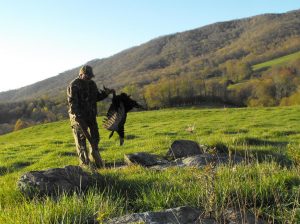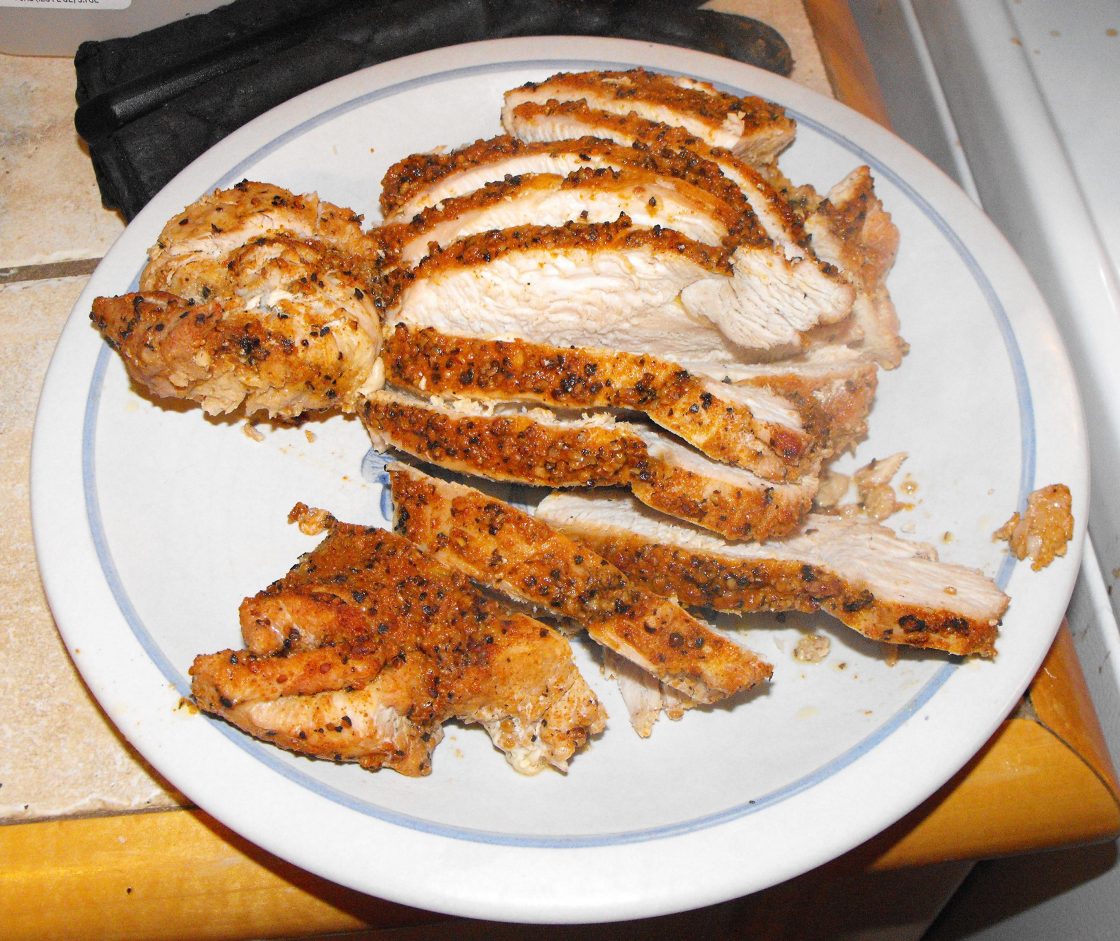WALT’S CAMPFIRE
EAT THAT TURKEY!
COPYRIGHT 2019
WALT HAMPTON
Before we get too romantic let me inject a little reality into this tome: although the adult tom turkey is indeed a beautiful creation, showy, with gorgeous plumage and a regal bearing, the truth is that biologically he is simply a sperm dispenser. He is a coward, a bully and a misogynistic bastard; he will try to forcibly breed every hen he can find and will destroy active nests to get the hen to recycle so she can be re-bred. He will displace other turkeys from feeding or breeding areas and when confronted with perceived danger he will tuck tail and run. He assumes no responsibility for the rearing of the young and will actually kill and eat small poults if he can catch them. As soon as the breeding season is over he abandons social interaction with others of his species and retires to the solitary, reclusive life of leisure. A grand trophy and fine eating, the old tom is a distinct challenge to hunt in a fair-chase, ethical manner because of his cryptic camouflage, his unbelievable hearing, his 270 degree, color-vision eyesight and his intimate knowledge of his home range. Calling an adult tom in to close range and killing him before he even knows that he has been fooled is the pinnacle of achievement in hunting success. Doing it in our beautiful Appalachian Mountains defines what spring turkey hunting was meant to be.
I do not hunt turkeys for their beards, spurs or feathers. I of course keep all those things, but truth be told I hunt them for my love of the meat. It is my Mother’s fault; Mother would scald the bird and wet-pick him, then slow roast him wrapped in tin foil or in a huge old enamel roasting pan, stuffed with her mouth-watering wet stuffing, loaded with the chopped liver and heart of the bird, and oysters, onions, celery and chestnuts. She inserted pats of real butter (be still my heart) under the skin and basted the bird regularly during cooking with his own juices, roasting it at 300 degrees for several hours. She carefully browned the bird the last 20 minutes under a low broiler to give the skin that golden brown color. If you walked into our house when this was happening the aroma was such that your tongue would slap your brains out trying to ingest the smell and you would need a bucket for the drool.
Hers was the old way of preparing the entire bird, and it is a good method, but takes a lot of time and preparation. We did not indulge the fancy, wine-and-oddball-herb type of cooking, we kept it simple and here is where my recipes differ from the “ooh-aah” fancy recipe books. If you want the glitzy, fancy methods then you need to buy another book; simple cooking is simply delicious. Turkey legs, thighs and back make great soup but are virtually inedible because of the tough, thick tendons. Remember, this is not an 8-week-old Butterball that stands in a crowded lot for a few weeks shoveling down cracked corn before meeting the reaper; the wild turkey walks hundreds of miles during his life and he has the running gear to show for it.
PREPARATION
The dead turkey gobbler is a ticking time bomb. With the heavy feather coat he wears and the high temperature of the internal organs, he is an incubator of bacteria and the successful hunter must be prompt in getting the insides out and the bird processed if he intends to enjoy the meat. I usually get a few photos then gut the bird, completely processing the carcass within an hour if possible. If you wait much longer than this you will see a green tinge around the edges of the meat and that, old boy, is bad news. Please, if you take nothing else away from this book, if you are successful in your turkey hunt please do not allow this magnificent bird to be wasted.
If I am going to bring the bird home “intact”, I cut around the anal opening and pull out the guts, then free the crop and cut the throat to free the esophagus and trachea, so they may also be removed, then wash the inside of the bird from the neck to the anal opening with cold water. If I have ice I pack the body cavity with it. This will delay decomposition but you must get the feathers off to completely cool the bird. Be sure in the gutting process to rake the lungs out from their cavities in the back of the bird and do your best to not allow any intestinal fluids to touch the meat.
The bird can be processed quickly by removing the beard for drying and skinning the bird, lying on its back, breast up, and filleting the meat right off of the breast bone. The legs and thighs for the soup pot can also be removed this way. This is the best method if the fry pan is the destination for the breast. A gallon zip-lock bag will hold the breast fillets of the biggest tom but a second bag will be needed for the other carcass parts. Get these bags into the cooler on ice or into the refrigerator as soon as possible. In the accompanying photo my son Wade is seen breasting a spring bird on the tailgate of his truck; once the bird has been checked in with the Game Department, we process them as soon as possible.
FRIED TURKEY BREAST AND GRAVY
No one on the Earth, and I mean no one, can fry a bird like Cecelia, my wife. She learned on chicken and oh, brother, is she ever a master of the fry pan. This is the usual method we use for our spring birds; we save the legs and thighs for soup or other dishes and we breast the bird for the fry pan.
Filet the breast meat from the bird, trimming all fat and cleaning the meat thoroughly. Slice the breast meat across the grain making turkey cuts approximately one inch wide and as thick as the breast filet, and as long as you desire. Mix flour, garlic powder and coarse-ground black pepper in a zip-lock bag and put the cuts in, rolling them around to completely cover the pieces. Get the pan (cast iron, of course) hot with canola oil or if you can afford it, virgin olive oil. Fry SLOWLY on low to medium heat until juices from pieces of turkey run clear, no blood. DO NOT OVERCOOK OR COOK ON TOO HIGH HEAT!!! Turkey will dry out very, very fast!
Once the meat is done, brown ½ cup flour (leavings from the coating) in the drippings, then add two cups cold milk, turn the heat up to medium high and stir continuously, until gravy thickens. Serve on the meat and biscuits.
BAKED
Frying the bird is my favorite way of serving the wild turkey, but with the older birds it may not be the best way. Turkeys are long-lived birds; one that was killed in Scott County a few years ago was wearing a Game Department leg band that had been placed on the bird 11 years before, and the records show that the bird was identified as an adult at the time of capture, making the turkey at least 13 years old. I would not expect a 13-year-old turkey to be a tender eater, and more finesse may be necessary to bring that old fellow on to the dinner plate. In the case of older (long spur) turkeys I like to bake the breast filets. Here we slow-cook the entire half-breast filet at a low temperature. The breast is rubbed with a herb-and-garlic mixture, wrapped in bacon (bacon makes everything better) and baked in a 250 degree oven for about two hours, once again just until the bacon is done and the juices run clear. Mashed potatoes and a garden salad go great with this dish.
The crock pot can also be used on the older birds but the slow-cooker can overcook the bird and unless you want turkey soup (the crock-pot can be the best way to prepare this) I usually just use the oven. For great turkey soup, use the freshest celery, onion and top-quality noodles and cube the turkey meat. The soup can be frozen and kept for up to 5-6 months.
Saturday morning, the 13th of April, is opening day of the Virginia spring gobbler season; this year I am looking for my 80th bird.
Thank you, Lord, for one more spring on the Mountain.
I’ll see You there.




